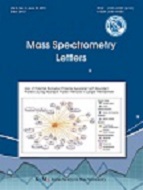
- P-ISSN 2233-4203
- E-ISSN 2093-8950

Studies on the interactions of amyloidogenic proteins with trace metals, such as copper, have indicated that the metal ions perform a critical function in the early oligomerization process. Herein, we investigate the effects of Cu(II) ions on the active sequence regions of amyloidogenic proteins using electrospray ionization mass spectrometry (ESI-MS) and collision induced dissociation tandem MS (CID-MS/MS). We chose three amyloidogenic peptides NNQQNY, LYQLEN, and VQIVYK from yeast prion like protein Sup35, insulin chain A, and tau protein, respectively. [Cu-peptide] complexes for all three peptides were observed in the mass spectra. The mass spectra also show that increasing Cu(II) concentrations decrease the population of existing peptide oligomers. The tandem mass spectrum of NNQQNY shows preferential binding for the N-terminal region. All three peptides are likely to appear to be in a Cu-monomer-monomer (Cu-M-M) structure instead of a monomer-Cu-monomer (M-Cu-M) structure.
Wagoner, V. A.. (2014). . Proteins Struct. Funct. Bioinforma., 82, 1469-. http://dx.doi.org/10.1002/prot.24515.
Jobling, M. F.. (2002). . J. Neurochem., 73, 1557-. http://dx.doi.org/10.1046/j.1471-4159.1999.0731557.x.
Stefani, M.. (2012). . Prog. Neurobiol., 99, 226-. http://dx.doi.org/10.1016/j.pneurobio.2012.03.002.
Abelein, A.. (2015). . Proc. Natl. Acad. Sci., 112, 5407-. http://dx.doi.org/10.1073/pnas.1421961112.
Sanchez-Lopez, C.. (2016). . Inorg. Chem., , -.
Gomes, C. M.. (2011). Protein folding and metal ions: mechanisms, biology and disease:CRC Press.
Krishna, N. R. S.. (2011). . Protein Pept. Lett., 18, 457-. http://dx.doi.org/10.2174/092986611794927929.
Xu, H.. (2014). . Front. Aging Neurosci., 6, 121-.
Pedersen, J. T.. (2011). . Angew. Chem. Int. Ed., 50, 2532-. http://dx.doi.org/10.1002/anie.201006335.
Seo, J. -H.. (2017). . Int. J. Mass Spectrom., 415, 55-. http://dx.doi.org/10.1016/j.ijms.2017.02.005.
Roepstorff, P.. (1984). . Biomed. Mass Spectrom., 11, 601-. http://dx.doi.org/10.1002/bms.1200111109.
Hunt, D. F.. (1986). . Proc. Natl. Acad. Sci. U. S. A., 83, 6233-. http://dx.doi.org/10.1073/pnas.83.17.6233.
Timari, S.. (2011). . J. Inorg. Biochem., 105, 1009-. http://dx.doi.org/10.1016/j.jinorgbio.2011.04.007.